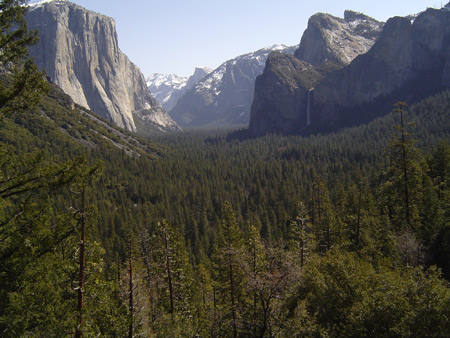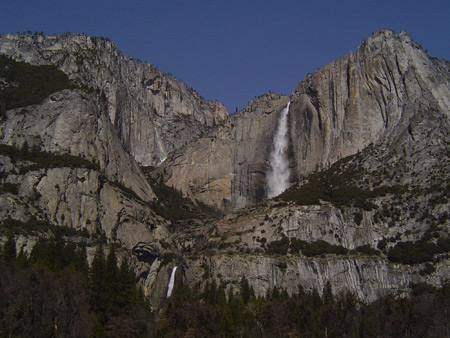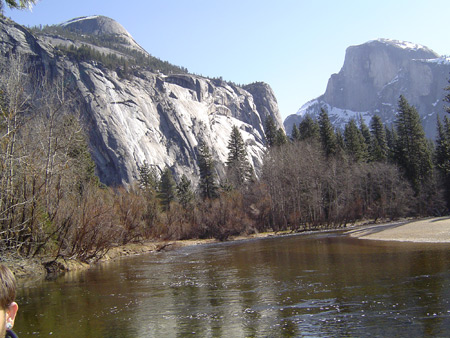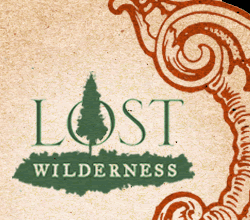Yosemite's Twin



When I was a kid, my family took the summer vacation obligatory for everyone in my corner of the Heartland — road tripping it in a Buick station wagon to Mount Rushmore — probably half a dozen times. George, Thomas, Teddy, Abe. Again and again, high up, sitting still as an old portrait and about as alive. The only thing I really remember is hearing a guide say once that Teddy has a huge piece of mica exposed near one earlobe, giving him what looks like an earring stud in certain light. And actually, there is something else I recall: the one time we Keans' escaped beyond Rushmore — five more hours along Wyoming highways as flat and unimaginative as the state's borders, to arrive at Yellowstone. Yellowstone! I've never spent much time at other national parks, so Rushmore and Yellowstone sort of defined the poles of experience for me — the dully dutiful tribute to our nation's heritage, and the sublime and terrifying wilds. Yellowstone got at me early, making it familiar, yet remained far enough distant that I couldn't get back, lifting it to the realm of remembrance. And it had enough strange sites — real mountains, spewing scalding water — to be practically Ceylon. In fact, Yellowstone swelled so large in my fancy that it engulfed America's other famous capital-Y wilderness. It didn't help that I watched Looney Tunes as a kid and knew all about Yosemite Sam, the orange-haired outlaw who meshed so well with the cowboy bars and horse corrals in the cities surrounding Yellowstone. Until last month, I would have bet you $150 Yosemite was right near Wyoming, probably in Montana. Guess what. *
I don't like being shaken out of my prejudices any more than the next fellow — we from the Heartland don't have much to defend anyway — but I have to admit that, now that I've visited both, Yosemite has surpassed Yellowstone for me, replaced it as the quintessential national park. But not for simple reasons. Probably nothing could have replaced Yellowstone just by being better, more spectacular. Things had to get complicated. I had to feel loss, too.
Of course what vaulted Yosemite into contention at all was indeed majesty, its feral majesty. The cliffs, the cliff-reflecting rivers, the condors, the bears punching through car windows; the floods, the wildfires, the rampaging history of soldiers and Indians and their wars; John Muir, Teddy Roosevelt (not just his granite face, but Theodore Roosevelt himself), Half-Dome, sequoias so gigantic they have goddamn tunnels carved into them. And unlike other grand places (I'm thinking of you, Grand Canyon), so inviting for humans, full of grass meadows — meadows neither mowed nor cleared but fully natural ** — meadows you could play baseball on and barely worry about a bad hop at short. I'd never been to California before and arrived late at night in the lamp-less dark, and went to sleep to a distant mysterious grumble. And when I emerged from my lodge at 7:00 a.m. the next morning and saw a 2,000 foot waterfall springing off a cliff — unlike Mt. Rushmore, this rock façade pulsed — I silently vowed I would never return to the state. How could anything live up?
I will return, of course; that was emotions making promises, the ones new lovers make at dawn. At the same time, I can't go back the same, because of what I found out about Yosemite while still burning with the first blush of emotion. Before explaining, I should pause to make a distinction. Yosemite properly means the whole national park, the three-quarters of a million acres amid the Sierra Nevada mountains in California's center. But when I say Yosemite, I'm mostly referring to Yosemite Valley, the Valley, a single mile-wide gash in the mountains carved out by glaciers during the last ice age. It's where 90 percent of visitors are drawn, the Old Faithful of the park — except this draw doesn't erupt and go silent. You're submerged in this valley, surrounded; like the Old Testament Yahweh, it just is. (That capital Y again .... ) It's the prime land, the first place American soldiers, high on manifest destiny, attacked Indian tribes. Because they coveted the valley. Because there are no other Yosemite Valleys on earth. At least not any more.
You see, after soaking in the Valley for a day, I found out something startling: it once had a companion, a twin. Hetch Hetchy Valley had been carved by glaciers in the same way, was adorned with the same pines and meadows and horsetail waterfalls. John Muir, the legendary conservationist and founder of the Sierra Club spent much of his early adulthood as basically a nomad in Yosemite park, tending sheep and finding timber. He knew its geography better than anyone ***, and Muir praised Hetch Hetchy as Yosemite Valley's equal. "One of Nature's rarest and most precious mountain temples," he called it. "The sublime rocks of its walls seem to glow with life ... leaning back in repose or standing erect in thoughtful attitudes ... brows in the sky, their feet set in the groves and gay flowery meadows ... birds, bees, and butterflies help[ing] the river and waterfalls to stir all the air into music — ... to draw her lovers into close and confiding communion with her."
There's a simple reason Hetch Hetchy Valley isn't renowned today — it drowned in 1923, submerged beneath hundreds of feet of water. Hetch Hetchy Valley is now Hetch Hetchy Reservoir, source of drinking water for San Francisco. It's a sad story, all too human. San Francisco never really stopped booming after the 1949 gold rush and Comstock silver lode. The local water source was controlled by a monopoly, and city leaders were scheming to build a free reservoir in not-too-distant Yosemite as early as 1902. Teddy Roosevelt, Yosemite camper and champion of national parks, literally vetoed the idea, but San Francisco earned a lot of national sympathy after the earthquake in 1906. More than the slipped fault lines and aftershocks, runaway fires had been what devastated the city, and San Franciscans argued (with pathos if not logos) that the disaster proved their need for a steady water supply. Damming Hetch Hetchy, they argued, was the only practical way, and wouldn't damn Yosemite anyway — it still had the Valley.
The dam proposal aroused the Sierra Club and especially Muir, a sometime writer and full-time loafer who seemed an unlikely activist. But the prospect of losing Hetch Hetchy mid-wifed some of his most passionate work. The passage above was a recollection of Hetch Hetchy Valley as it faced destruction. More pithily, he once exclaimed, "Dam Hetch Hetchy! As well dam for water-tanks the people's cathedrals and churches, for no holier temple has ever been consecrated by the heart of man." But supporters of the project had powerful allies, and Congress took up the matter again in 1913. And when the bill passed this time, waiting for it in the White House was Woodrow Wilson, the idealist, abstracting over Europe's troubles. He signed, and within a decade the Hetch Hetchy wilderness went the way of Gilgamesh's friends and Noah's wicked brethren.
How to grasp such a loss? There's the rationalizing way: To acknowledge that Yosemite wasn't pure even when Muir arrived. Much of the landscape, especially the trees, had been shaped by local Indians, who set controlled fires to "farm" and harvest acorns. (Leveling fires helped the local black oaks compete and thrive against taller trees.) So man had already upset the balance of Yosemite long before Hetch Hetchy. What's more, Nature herself changes. Those flat untangled meadows on the valley floor are actually being replaced by forest ****, and humans have nothing to do with it. After the glaciers cleared out millennia ago, a giant melt-lake settled down in the valley. The lake drained eventually, and gave way to drier marshland; and the marshland drained and gave way to drier meadows; and the meadows are now drying and giving way to forest. The sphincter is tightening around the meadows, and actually without human intervention they, too, will disappear.
For whatever reason we humans consider ourselves apart from nature, separate. And in a way that beavers damming rivers don't, or grasses holding soil together don't, we fret that what we do to change the landscape is unnatural. We distinguish between the meadows drying out, something unplanned, and the planned drowning of Hetch Hetchy. And those of us mostly likely to argue that humans must, for the greater good, see themselves as part of the natural world are the very ones who feel the strongest that what seems to come most naturally to humans — expanding into and exploiting our surrounding, what we've been doing since time immemorial — is most unnatural. Even when the tension is pointed out to us, we cannot help not feel it.
But I suspect for Muir the scale of Hetch Hetchy and the swiftness were too great. The battle over Hetch Hetchy was the biggest of Muir's life, and when he lost it, he more or less gave up on life. He died on Christmas Eve, 1914, one year and five days after Wilson signed the project into law. I'm an easy-going materialist, but a materialist still — I don't believe in spirit or soul or mind apart from corporal body. And yet it makes perfect sense to me that when Muir lost the will to live, when his ephemeral mind lost interest in the world his body was immersed in, the whole package shut down and died. Here, the "spirit" was in charge. Because despite what a dictionary might claim, loss is not an abstract noun. It's there, it's felt. Loss is material.
And even though, ironically, I can't fathom what losing Hetch Hetchy felt like to Muir after a lifetime in greater Yosemite, because I found out about the loss so quickly, within a day of first arriving in the Valley and still emotional — there was another one of these, and it's gone? — I, too, could feel a stirring of the same loss. And that's what gets at me in a way the other, uncomplicated-for-me capital-Y wilderness in America can't quite.
FOOTNOTES:
*: At least I'm not alone. Yosemite rangers say one of the most common questions they get is, "Where's the geyser anyway?" (Although in the Pantheon of asinine questions that public guides get, that's mild. I talked with some people at Kennedy Space Center recently, too, and visitors there regularly get indignant when they find out there's no anti-gravity room.)
**: (You'll see)
***: He knew it so well in fact that President Roosevelt, when he visited the park, shunned the luxury hotels in Yosemite park that were spit-shining the doorknobs to welcome him and decided to sleep in a grubby tent on the pine needles in the woods with brother John. After living in Washington, D.C., and watching the daily panicked fire drill of moving the president even across town for a hamburger, the fact that Theodore Roosevelt actually slept in the unguarded woods blew my mind almost as much as the thousand-foot waterfalls.
****: Which means it's anti-deforestation, the opposite of what's happening in Brazil and Africa and everywhere else right now.
Photos courtesy Sam Kean.
BACK TO TOP
===========================================================================================
|







 Print
Print